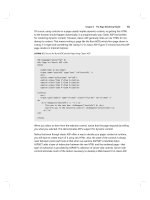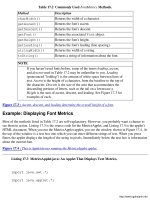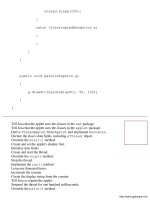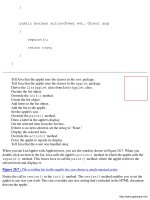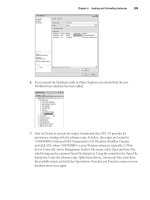Linux Socket Programming by Example PHẦN 4 ppt
Bạn đang xem bản rút gọn của tài liệu. Xem và tải ngay bản đầy đủ của tài liệu tại đây (866.44 KB, 51 trang )
From the session shown, you can see that the client program
prompts you for input. The first input was just the simple pair of
characters %D and a RETURN. The result came back from the
server as '08/13/99'. Note that the socket address of the
datagram sender was reported, and it agreed with the server
address that was expected (the program default). Another input
of %A %D %H:%M:%S was tried with the server returning the result
of 'Friday 08/13/99 22:14:02'. Finally, the input quit was provided,
and both the client program and the server program exited.
Testing with No Server
The following shows what happens when the client program is
run, and no server is running:
$ ./dgramclnt
Enter format string: %D
Connection refused: recvfrom(2)
$
Note that the client program is able to start up, create the
socket, and ask for input. Even the sendto(2) function was
reported as successful (the error message came from the
recvfrom(2) statement which follows the call to sendto(2)). This
confirms the fact that sending a datagram only confirms that it
was sent out—not that it was successfully received.
In this particular situation, the program was lucky enough to get
an error response to indicate that no server was listening on
that address and port. The error indication was picked up by the
recvfrom(2) function call. When the client and server are
separated by a large network and many routers, this error
indication may not always be received.
In practice, you cannot rely on getting the error if the other end
is not listening. For this reason, UDP programs often include the
use of timers, and assume that no contact was made if no
response is received within a certain amount of time.
Testing with Other IP Numbers
In the preceding sections, it was mentioned that an IP number
could be given on the command line. If you have your own
network set up, you can try running the client and server
programs on different hosts. In the next example, the server
Linux Socket Programming by Example - Warren W. Gay
155
will be started on host 192.168.0.1, and the client program will be
run from 192.168.0.2. The following shows the server startup:
$ ./dgramsrvr 192.168.0.1 &
[1] 4416
$
With the server successfully started up, the client program is
invoked on the other host. The following session shows the
output seen from the client end:
$ ./dgramclnt 192.168.0.1
Enter format string: %D
Result from 192.168.0.1 port 9090 :
'08/13/99'
Enter format string: %A (%D)
Result from 192.168.0.1 port 9090 :
'Friday (08/13/99)'
Enter format string: QUIT
$
As shown, the client program was told that the server was
located at address 192.168.0.1 by providing the address on the
command line. A couple of examples were tried, and then the
QUIT command was given. The pair of programs demonstrated
themselves as working correctly.
While this example shows flawless execution, keep in mind that
UDP is unreliable. If the client program fails to get a response
from the server, it will hang (at line 111 in Listing 6.2). If you
were writing a production mode application, you'd need to
provide code for a timeout. This would allow the program to
recover from the lack of a response when the original or
response datagrams are lost.
Leaving Out bind(2) in Client Programs
Some observant readers might have noticed that no call to
bind(2) was made in the client program for the socket that was
created in Listing 6.2. If the bind(2) function call can be
eliminated, then why bother with it at all?
You'll remember that in Chapter 5, "Binding Addresses to a
Socket," there was a section titled "Interfaces and Addressing"
Linux Socket Programming by Example - Warren W. Gay
156
which explained that the bind(2) function could be used to
restrict the interfaces that would be used to perform
communications. The example used in Figure 5.1 was a firewall
application program that only wished to communicate with a
trusted internal network. If this seems vague to you right now,
you might want to turn back there and review how bind(2)
accomplished this.
In Listing 6.2, the call to bind(2) was omitted. So what does this
omission imply for the sending socket? As you know from
Chapter 5, this actually indicates that the program will accept
any outgoing interface, as required by the routing of the
datagram to its destination. In effect, the socket is said to have
a wild socket address. Later, when the program waits for a
response, it will accept an input datagram from any incoming
interface as well. Note also that this socket's port number is
also wild. In this particular application, any client port number
is acceptable.
You can explicitly request a wild address and port with a call to
bind(2). Listing 5.6 showed you how this was done by using the
wild address INADDR_NONE. To request a wild port number, the
port number is given as zero. By combining INADDR_NONE for the
IP number and a port number of zero, you have requested that
bind(2) give you the same wild address explicitly that you would
have used without a call to bind(2).
Replying to a Wild Address
If the client program's address and port number are wild, you
might wonder how the server was able to reply to that
particular socket. After all, how do you write a response back to
the client without a specific IP address and UDP port number?
The answer to this question lies in the fact that an IP number
and port number are assigned at the time the datagram is sent.
The previous session shown occurred on the host with an IP
number of 192.168.0.2. When the client program called the
sendto(2) function, the datagram was known to be destined for
host IP number 192.168.0.1. The routing tables indicated that the
Ethernet interface with IP number 192.168.0.2 would be used to
send the datagram to that host. Consequently, the sending
datagram had a "from" address of 192.168.0.2. This was the
address seen at the server end. The port number, however, was
wild and would have been chosen as any one of the free port
numbers for the IP number chosen.
Linux Socket Programming by Example - Warren W. Gay
157
If another datagram is destined to a different network, then its
"from" IP number will be different again. The "from" address will
reflect the IP number of the network interface used to send the
datagram.
This is an important concept to grasp and is perhaps one of the
most difficult things for the beginner to grapple with. If your
understanding is not yet complete on this, you should review
Chapter 5 until you have a thorough understanding. As an
exercise, you can add the following printf(3) statement to the
server in Listing 6.1, immediately after the recvfrom(2) function
call (after line 107):
printf("Client from %s port %u;\n",
inet_ntoa(adr_clnt.sin_addr),
(unsigned)ntohs(adr_clnt.sin_port));
With this line added, perform the following steps:
1. Kill or take down the existing server(s) if it (they) are still
running.
2. Recompile the server dgramsrvr.
3. Restart the server (on 192.168.0.1, for example).
4. Run the client program again (from 192.168.0.2, for
example).
The following line was displayed when the client on 192.168.0.2
sent the server on 192.168.0.1 a datagram:
Client from 192.168.0.2 port 1026;
This confirms the fact that an IP number was assigned at the
client end, and the port number assigned was 1026 in this
example. This information enabled the server to direct its
response back to the original requesting client.
If you lack a network, you can still perform this experiment on
your standalone PC. First, start the server, using its default
address:
$ ./dgramsrvr &
Now run your client program:
$ ./dgramclnt
Linux Socket Programming by Example - Warren W. Gay
158
The output of your server program and client program will mix if
run from the same terminal window (you can, however, run
them from separate windows if you like). The following session
shows the server and client output, when they are run on a
single standalone PC, within the same terminal window.
$ ./dgramsrvr &
[1] 733
$ ./dgramclnt
Enter format string: %D
Client from 127.0.0.23 port 1027;
Result from 127.0.0.23 port 9090 :
'08/15/99'
Enter format string: %A %D
Client from 127.0.0.23 port 1027;
Result from 127.0.0.23 port 9090 :
'Sunday 08/15/99'
Enter format string: QUIT
Client from 127.0.0.23 port 1027;
[1]+ Done ./dgramsrvr
$
Notice that for all datagrams sent to the server, the datagram
from address was reported as
Client from 127.0.0.23 port 1027;
Again, this confirms that the correct IP address and a final port
number are assigned upon demand, whenever bind(2) is not used
on the client's sending socket.
What's Next
This chapter introduced you to the concept of connectionless-
and connection-oriented communication. The UDP protocol was
used to explore and demonstrate this connectionless mode of
communication.
You have demonstrated your ability to write a client and server
program using the UDP network protocol. Don't stop here,
however, because UDP isn't always the best choice for
applications.
The next chapter will show you another mode of communication
for client and server. There you will learn about the connection
Linux Socket Programming by Example - Warren W. Gay
159
mode of communication using a TCP/IP client program. So, hang
onto your red hat!
Chapter 7. Connection-
Oriented Protocols for Clients
You'll recall from the last chapter that there are two basic
modes of communication for sockets. They are connection and
connectionless modes of communication. In the last chapter,
you also saw how the UDP protocol could be used to
communicate in a connectionless fashion. In this chapter, you'll
put the TCP/IP protocol to use, using a connection-oriented form
of communication.
This chapter will introduce you to
• The advantages of connection-oriented protocols
• The /etc/services file and its support routines
• The /etc/protocols file and its support routines
• The connect(2) function
• How to write a TCP/IP client program
Before you jump in and write your first client program, however,
a quick review and an introduction to connection-oriented
communications is in order. Additionally, you'll learn about
some of the support functions that are often used by TCP/IP
programs that locate service and protocol information.
Reviewing the Methods of Communication
It was also noted in the last chapter that connectionless-
oriented communication is simpler and more flexible. But you'll
see that connection-oriented communication is not really that
much more difficult. It does require additional steps, however,
and mostly on the server side. A connection is also much more
rigid, because after the connection has been established, the
socket can only communicate with the connected endpoint.
The selling point in favor of TCP/IP for most application writers
is that the communication channel is transparently reliable and
that data is delivered in the proper sequence. After the
connection has been established, your application can read and
Linux Socket Programming by Example - Warren W. Gay
160
write to the socket without worrying about any of the following
problems:
• Lost packets
• Timeouts and retransmissions
• Duplicated packets
• Packets received out of sequence
• Flow control
Like opening a file, your program can
1. Establish a TCP/IP connection with a remote socket
2. Transmit large amounts of data
3. Close the socket
These simple steps are all that is necessary to deliver all of your
data safely to the remote end. Proven error recovery software
will take care of retransmitting lost packets until they can be
successfully delivered to the remote host.
TCP/IP Handles Lost Packets
TCP/IP will notice when packets are lost. This does not always
happen with UDP. When packet errors are reported, the TCP/IP
protocol can immediately respond with retransmissions.
However, if an acknowledgement is missing, causing a timeout,
the TCP/IP protocol takes steps to ensure that the data is
retransmitted to its destination. Carefully crafted algorithms
are used to make the transmission of the data nimble, without
taxing the network capacity with retransmitted data.
TCP/IP Handles Duplicated Packets
Whenever a retransmission occurs, there is a slight possibility
that more than one identical packet can be received at the
remote end. If the retransmission occurs too early, for example,
this can easily happen. The receiving end must be able to
recognize this and discard extraneous packets. This is
automatically performed by the TCP/IP protocol.
TCP/IP Handles Sequencing
When the volume of data requires multiple packets to be sent,
there is a race to the finish line. The IP packet can be routed in
different ways, according to dynamic routing and buffer
Linux Socket Programming by Example - Warren W. Gay
161
congestion. This results in a race to the receiving end, where
some packets can arrive ahead of other packets. For this
reason, the receiving software must recognize this and
sequence the data before presenting it to the application.
Again, TCP/IP anticipates and corrects this problem.
TCP/IP Handles Flow Control
The ftp command uses TCP/IP to send and receive files. When
you upload a large file to a remote ftp server, using the ftp send
command, many data packets are placed on the network. It can
happen that the receiving host can end up receiving packets
faster than it can process them. The IP way of dealing with this
problem is to discard these extra packets.
TCP logically sits on top of the IP protocol like a layer (hence, it
is called TCP/IP). It acts as a supervisor of sorts by ensuring that
the receiving end is not overloaded with more data than it can
handle. When the receiving end feels that it has enough data for
the moment, it notifies the sending end not to send more data
until further notice. When it catches up, the remote end will
signal the sending end to start sending data again. This
automatic throttling of data is known as flow control.
Understanding the Advantages of TCP/IP
The purpose of this introduction was to show you the advantage
of using a connection-oriented protocol. TCP/IP is one such
connection-oriented protocol, which you will explore in this
chapter. You have seen the number of services it performs for
you behind the scenes. This helps you to focus on your
application programming, rather than network communication
problems. Furthermore, because the same time-tested
algorithms are at work for each program that uses TCP/IP, they
perform in the same reliable manner. This allows you to focus
on application program bugs instead.
Internet Services
Before you have fun working with TCP/IP in this chapter, you
need to learn about some additional facilities as TCP/IP pertains
to Internet services.
Linux Socket Programming by Example - Warren W. Gay
162
Examining the /etc/services File
Your Linux system has a text file, usually named /etc/services.
This file is described in the man page services(5). This file maps
the user-friendly names of certain Internet services to a port
number and protocol. The precise pathname for this file is given
by the C language macro _PATH_SERVICES. A simple example of its
use follows:
#include <netdb.h>
printf("File is path '%s'\n", _PATH_SERVICES);
The preceding code shows the necessary include file netdb.h and
a printf(3) statement, which prints out the pathname for the
services file.
Each text line in the /etc/services file describes one Internet
service. It has the following general format:
service-name port/protocol [alias …]
The square brackets shown indicate that the one or more alias
entries are optional. The /etc/services text line is described in
detail in Table 7.1.
Table 7.1. The /etc/services Fields
Field Description
service-
name
The case-sensitive user-friendly name of the service is
described by this table entry.
port
The port number precedes the slash, and is the
decimal port number for the service.
/
This separates the port number from the protocol field.
protocol
This specifies the type of the protocol to be used. This
should be a protocol that can be found in the
protocols(5) file. Common examples are udp or tcp.
alias
Other names for the "service-name." Additional aliases
can be separated by tabs or spaces. There is a
maximum of 35 aliases permitted, due to restrictions
in getservent(3).
Following is a pair of well-known service entries:
Linux Socket Programming by Example - Warren W. Gay
163
ftp 21/tcp
telnet 23/tcp
The first entry shown lists the ftp service as being available on
TCP/IP port 21. The second entry shows the telnet service being
available on TCP/IP port 23.
Working with the /etc/services file directly is neither convenient
nor wise for your program. Consequently, Linux provides you
with some routines to make things easier.
Using Function getservent(3)
If you have used some of the password database functions like
getpwent(3) before, the functions about to be described here will
seem similar. The synopsis of the getservent(3) function is as
follows:
#include <netdb.h>
struct servent *getservent(void);
For each call to getservent(3), you are returned a pointer to a
structure that represents one entry from the /etc/services file.
When the end-of-file is reached, a NULL pointer is returned (but
see the caution that follows). If an error occurs, a NULL pointer is
also returned, with the reason for the error posted to variable
errno.
Caution
Even when the value of errno is zeroed prior to calling
getservent(3), when end-of-file is reached and indicated by a NULL
return pointer, the errno value for Red Hat Linux 6.0 is code
ENOENT.
Under other UNIX operating systems, such as HP-UX 10.2 and
Sun Solaris 5.5.1, the errno value is left at zero when end-of-file
is returned. This leads the author to speculate that this
behavior is a bug, which might be corrected in a later release of
Linux.
When the pointer returned is not NULL, it points to the structure
servent, as illustrated in Listing 7.1.
Linux Socket Programming by Example - Warren W. Gay
164
Listing 7.1 The struct servent Structure
struct servent {
char *s_name; /* official service name */
char **s_aliases; /* alias list */
int s_port; /* port number */
char *s_proto; /* protocol to use */
}
Caution
Be careful to note that the value in s_port is already in network
byte order. To print this value in printf(3), for example, make
sure you convert this value back to host order by using ntohs(sp-
>s_port), for example.
When setting the port number in a socket address, you merely
assign this value as-is, since the port number is expected to be
in network byte order. Listing 7.7 later in this chapter shows an
example of this use.
The structure member s_aliases is actually an array of character
pointers. If sp points to the structure, and x is an int subscript,
then you can iterate through each alias sp->s_alias[x], until you
reach a NULL pointer. A NULL pointer marks the end of this alias
list. Listing 7.2 shows a simple program that lists all /etc/services
entries and their aliases, if any.
Listing 7.2 servent.c—A Program to List All Services
1: /* servent.c:
2: *
3: * Example getservent(3) program:
4: */
5: #include <stdio.h>
6: #include <unistd.h>
7: #include <stdlib.h>
8: #include <errno.h>
9: #include <string.h>
10: #include <netdb.h>
11: #include <netinet/in.h>
12:
13: int
14: main(int argc,char **argv) {
15: int x;
16: struct servent *sp;
17:
18: for (;;) {
19: errno = 0;
20: if ( !(sp = getservent()) )
Linux Socket Programming by Example - Warren W. Gay
165
21: break;
22:
23: printf("%s:\n"
24: "\tPort: %d\n"
25: "\tProtocol: %s\n"
26: "\tAliases: ",
27: sp->s_name,
28: ntohs(sp->s_port),
29: sp->s_proto);
30: for ( x=0; sp->s_aliases[x] != NULL; ++x )
31: printf("%s ",sp->s_aliases[x]);
32: putchar('\n');
33: }
34:
35: if ( errno != 0
36: && errno != ENOENT ) /* For RH-6.0 */
37: fprintf(stderr,
38: "%s: getservent(3) %d\n",
39: strerror(errno),errno);
40:
41: return 0;
42: }
The program in Listing 7.2 uses the following basic steps:
1. Calls getservent(3) to obtain an entry from the /etc/services
file.
2. Prints the service name, port, and protocol.
3. In an internal loop, prints all alias names, if any.
4. Repeats step 1, until there are no more entries.
Now looking at the program in more detail:
1. Line 10 shows that netdb.h was included. This defines the
function prototype for getservent(3). Line 11 includes
netinet/in.h to define ntohs(), which is used in line 28.
2. Line 16 declares a pointer to struct servent, which is named
as sp.
3. Line 19 zeros the value of errno. The author suspects that
getservent(3) should leave errno as zero when end-of-file is
reached. However, Red Hat Linux 6.0 returns with ENOENT
in errno at present, when end-of-file is reached. Just be
aware that this might be fixed in the future.
4. The pointer is returned from getservent(3) and assigned to
variable sp (line 20). If the pointer is NULL, line 21 breaks
out of the loop.
5. Lines 23 to 29 display the service name, port, and
protocol.
6. Lines 30 and 31 report all aliases, if any.
Linux Socket Programming by Example - Warren W. Gay
166
7. The program repeats step 3 until no more entries remain
in the /etc/services file.
8. Lines 35 and 36 try to distinguish between end-of-file and
an error. Red Hat Linux 6.0 indicates ENOENT, but zero may
be indicated in the future (if this behavior is indeed a bug).
9. Lines 37 to 39 report the error, if step 8 identifies that an
error has occurred.
Caution
The pointer returned by getservent(3) is only valid until the next
call to the same function.
Listing 7.3 shows how to compile and run the program in Listing
7.2. In this example, the output was piped to the head command
to show only the first few lines of output.
Listing 7.3 Compiling and Running servent.c from Listing 7.2
$ make servent
gcc -c -D_GNU_SOURCE -Wall servent.c
gcc servent.o -o servent
$ ./servent | head
tcpmux:
Port: 1
Protocol: tcp
Aliases:
echo:
Port: 7
Protocol: tcp
Aliases:
echo:
Port: 7
Broken pipe
$
The error message "Broken pipe" in Listing 7.3 is simply due to
the head command being used (it closed the pipe early). There
are some companions to the getservent(3) function, and these will
be covered next.
Using the setservent(3) Function
The setservent(3) function allows you to rewind the file that is
opened behind the scenes in the function getservent(3). For
example, if you were to try to process entries a second time in
Listing 7.2, you would need setservent(3) to rewind to the start of
Linux Socket Programming by Example - Warren W. Gay
167
the /etc/services file. Otherwise, you will just continue to receive
end-of-file indications. The function synopsis is as follows:
#include <netdb.h>
void setservent(int stayopen);
This function takes one argument, which is a Boolean value:
• When non-zero (TRUE), the stayopen argument indicates that
the file should be rewound instead of re-opened when
rereading the /etc/ services file is performed. This is
preferred for performance reasons.
• When zero (FALSE), the file is closed if it has been
previously opened (by getservent(3), for example). Then the
function re-opens the file to make ready for the next
getservent(3) call.
There is no return value for this function.
Using the endservent(3) Function
The function getservent(3) opens the /etc/services file behind the
scenes, before returning a pointer to an entry. If your
application has determined that it no longer needs to read more
entries, then the endservent(3) function can be used to cause the
file to be closed. This is especially important in server programs
where the number of open file descriptors may be at a premium.
The function synopsis is as follows:
#include <netdb.h>
void endservent(void);
There is no argument, no return value, and no errors to test.
Looking Up a Service by Name and Protocol
The previously introduced functions enable you to scan the
/etc/services file one entry at a time. Often, however, this still
proves to be inconvenient because of the amount of code
involved. Instead, it would be more convenient to supply the
service name and protocol, and have a function return the
required entry. The getservbyname(3) function does just that. The
function synopsis is as follows:
#include <netdb.h>
Linux Socket Programming by Example - Warren W. Gay
168
struct servent *getservbyname(const char *name, const char *proto);
The arguments to the function are as follows:
1. The service name to look up. For example, "telnet" could be
used.
2. The protocol to be used (proto). Often a service will be
available using UDP or TCP/IP. Consequently, you must
specify the protocol that you are willing to use in order to
contact that service. An example would be "tcp."
The value returned is NULL if the service cannot be found.
Otherwise, a pointer to a structure servent is returned. An
example of its use is shown as follows:
struct servent *sp;
sp = getservbyname("telnet","tcp");
if ( !sp )
abort(); /* No such service! */
If the function call is successful, the structure pointer sp will
point to all of the pertinent details, including the port number.
Caution
The pointer returned by getservbyname(3) is only valid until the
next call to the same function.
Looking Up a Service by Port and Protocol
You saw in the last section that it was possible to look up a
service by name and protocol. The function getservbyport(3)
allows you to also perform a lookup by port and protocol. The
function synopsis is as follows:
#include <netdb.h>
struct servent *getservbyport(int port, const char *proto);
The function arguments are as follows:
1. The port number for this Internet protocol.
2. The protocol proto to be looked up for port.
Linux Socket Programming by Example - Warren W. Gay
169
The function returns a NULL pointer if no service entry can be
found to match your input parameters. Otherwise, a pointer is
returned to the structure containing information, such as the
service name, for example.
Caution
The pointer returned by getservbyport(3) is only valid until the
next call to the same function.
Consulting the /etc/protocols File
Earlier, in Table 7.1, there was mention made that the protocol
used there must appear in the protocols(5) table. The text file
/etc/protocols acts as a mini-database of various defined Internet
protocol values. There is a set of functions, which perform in a
very similar manner to the service entry functions that were just
covered. These act as convenience functions, should you need
them. These functions are so similar, in fact, that they do not
need to be covered in detail. The function synopsis of
getprotoent(3) is as follows:
#include <netdb.h>
struct protoent *getprotoent(void);
The getprotoent(3) function returns one /etc/protocols entry with
each call. A NULL pointer is returned when end-of-file or an error
has been encountered. Listing 7.4 shows the protoent structure
that is returned by the function call.
Caution
The pointer returned by getprotoent(3) is only valid until the next
call to the same function.
Listing 7.4 The struct protoent Structure
struct protoent {
char *p_name; /* official protocol name */
char **p_aliases; /* alias list */
int p_proto; /* protocol number */
}
The structure members are more fully described as follows:
Linux Socket Programming by Example - Warren W. Gay
170
• The structure member p_name contains a pointer to a C
string that names the protocol (for example "tcp").
• The member p_aliases is a pointer to an array of C string
pointers, of which the last entry is a NULL pointer. If pp
points to this structure, then pp->p_aliases[0] contains the
first C string (or is NULL when there are no aliases). An
example of an alias might be "TCP" (the uppercase name of
the protocol is often specified as an alias).
• The member p_proto contains the protocol number. For
example, the protocol number found in /etc/protocols for
entry "tcp" should agree with the C macro constant
IPPROTO_TCP. If you check with /usr/include/netinet/in.h and with
the value in /etc/protocols, you will indeed see that they both
have the value 6.
Caution
The getprotoent(3) function suffers from the same flaw as the
getservent(3) function under Linux. Even when the value of errno is
zeroed prior to calling getprotoent(3), when end-of-file is reached
and indicated by a NULL return pointer, the errno value for Red
Hat Linux 6.0 is ENOENT.
Under other UNIX operating systems, such as HP-UX 10.2 and
Sun Solaris 5.5.1, the errno value is left at zero when end-of-file
is returned. This leads the author to speculate that this
behavior is a bug, which might be corrected in a later release of
Linux.
The getprotoent(3) function returns a NULL pointer when end-of-
file is reached or when an error has been encountered.
Listing 7.5 shows a demonstration program that iterates
through all of the /etc/protocols database entries.
Listing 7.5 protoent.c—The getprotoent(3) Demo Program
1: /* protoent.c:
2: *
3: * Example getprotoent(3) program:
4: */
5: #include <stdio.h>
6: #include <unistd.h>
7: #include <stdlib.h>
8: #include <errno.h>
9: #include <string.h>
Linux Socket Programming by Example - Warren W. Gay
171
10: #include <netdb.h>
11:
12: int
13: main(int argc,char **argv) {
14: int x;
15: struct protoent *pp;
16:
17: for (;;) {
18: errno = 0;
19: if ( !(pp = getprotoent()) )
20: break;
21:
22: printf("%s:\n"
23: "\tProtocol: %d\n"
24: "\tAliases: ",
25: pp->p_name,
26: pp->p_proto);
27: for ( x=0; pp->p_aliases[x] != NULL; ++x )
28: printf("%s ",pp->p_aliases[x]);
29: putchar('\n');
30: }
31:
32: if ( errno != 0
33: && errno != ENOENT ) /* For RH-6.0 */
34: fprintf(stderr,
35: "%s: getprotoent(3) %d\n",
36: strerror(errno),errno);
37:
38: return 0;
39: }
The program code in Listing 7.5 is so similar to the program in
Listing 7.2 that only the basic steps need to be repeated here.
They are
1. Call getprotoent(3) to obtain an entry from the /etc/protocols
file.
2. Print the protocol name and the protocol number.
3. In an internal loop, print all protocol alias names, if any.
4. Repeat step 1 until there are no more protocol entries.
Listing 7.6 shows how to compile and run the demonstration
program.
Listing 7.6 Compiling and Running the protoent.c Program
$ make protoent
gcc -c -D_GNU_SOURCE -Wall protoent.c
gcc protoent.o -o protoent
$ ./protoent | head
ip:
Protocol: 0
Aliases: IP
Linux Socket Programming by Example - Warren W. Gay
172
icmp:
Protocol: 1
Aliases: ICMP
igmp:
Protocol: 2
Aliases: IGMP
ggp:
$
The example command session in Listing 7.6 had its output
piped to the head command to keep the listing short. Notice the
protocol name of the first entry shown was "ip" and its one and
only alias was the uppercase name "IP".
Using the setprotoent(3) Function
The file that is opened implicitly for getprotoent(3) can be
rewound by calling the setprotoent(3) function. The function
synopsis for it is as follows:
#include <netdb.h>
void setprotoent(int stayopen);
This function accepts one argument, stayopen, which is
interpreted as a Boolean value:
• When stayopen is non-zero (TRUE), this indicates that the
implicitly opened file is left opened and merely rewound to
the start of the file.
• When stayopen is zero (FALSE) this indicates that the
implicitly opened file is closed and then re-opened,
effectively rewinding the file.
Best performance is obtained by setting stayopen as TRUE.
Using the endprotoent(3) Function
When your program is finished consulting with the /etc/protocols
file, it can request that the implicitly opened file be closed. This
is especially important for server programs to do, because file
descriptors are often scarce. The function prototype for
endprotoent(3) is given as follows:
#include <netdb.h>
void endprotoent(void);
Linux Socket Programming by Example - Warren W. Gay
173
There are no arguments to this function, and there are no return
value or errors to check.
Looking Up a Protocol by Name
Sometimes it is necessary for an application program or utility
program, which can work with multiple protocols, to look up a
protocol by name. While this can be done by using the previous
functions, getprotobyname(3) saves the programmer some effort.
The function prototype is as follows:
#include <netdb.h>
struct protoent *getprotobyname(const char *name);
The one input argument is a C string containing the protocol
name ("udp", for example). The value returned is a pointer to the
protoent structure, or is a NULL pointer, indicating that it could
not be found.
Caution
The pointer returned by getprotobyname(3) is only valid until the
next call to the same function.
Looking Up a Protocol by Number
When your application has the protocol number, and it needs to
display it in human readable terms, the getprotobynumber(3)
routine is used. The function prototype is as follows:
#include <netdb.h>
struct protoent *getprotobynumber(int proto);
This function accepts the protocol number as the input
argument, and returns the pointer to a protoent structure if a
match is found. Otherwise, the NULL pointer is returned to
indicate that the protocol is not known by the mini-database.
For example, if the input argument is 6 (or the C macro constant
IPPROTO_TCP), then you should get a structure pointer returned
that has the value "tcp" in the member p_name.
Caution
Linux Socket Programming by Example - Warren W. Gay
174
The pointer returned by getprotobynumber(3) is only valid until the
next call to the same function.
This brings you to the end of the getservent(3) and the
getprotoent(3) function families. Now that you know how to look
up Internet-related services and protocols, it is time to write a
connection-oriented client program using TCP/IP.
Writing a TCP/IP Client Program
Using TCP/IP for a connected pair of sockets requires that a
slightly different procedure be used from the one you used
when using the UDP protocol in the previous chapter. From the
client program's point of view, you must perform the following
general steps:
1. Create a socket.
2. Optionally bind the socket (to restrict which interface will
be used, or to explicitly indicate a wild socket address).
3. Connect to the remote socket (client connects to the
server).
4. Communicate with reads and writes.
5. Shut down or close the socket.
When you used the UDP protocol, you performed all of the
above steps except for step 3. You never had to connect to
anything, because you were using a connectionless protocol.
The next section will describe a new socket function for you.
Introducing the connect(2) Function
In order to establish a connection with sockets, you call upon
the connect(2) function. Its function synopsis is as follows:
#include <sys/types.h>
#include <sys/socket.h>
int connect(int sockfd, struct sockaddr *serv_addr, int addrlen);
This function takes three arguments. They are
1. The socket file descriptor sockfd that was returned by a
former call to socket(2).
Linux Socket Programming by Example - Warren W. Gay
175
2. The server address serv_addr that the program is
connecting to.
3. The length addrlen of the server address in bytes.
The server address and the server address length are the same
socket address values that you would have supplied in a call to
the sendto(2) function, if you were using UDP. The difference with
connection-oriented protocols, however, is that you only
establish the destination address once. After this function
succeeds, all future communications will be with the socket
addressed here.
When the function call is successful, the return value is zero.
Otherwise, -1 is returned to indicate that an error has occurred,
and the nature of the error is recorded in the variable errno.
Preparing to Write the Client Program
To keep the client program short and allow you to focus upon
the basic principles, the demonstration program is going to
connect to an existing service you have running on your system.
The client program will connect to your daytime service to
retrieve the current date and time string.
Before the program is presented, however, you should make
sure that this service is enabled and operational on your
system. As a first step, perform the following:
$ grep daytime /etc/services
daytime 13/tcp
daytime 13/udp
$
You should see that your system recognizes the daytime Internet
service and that it is available on port 13 using tcp. The first line
of grep output confirms this for you.
Tip
The telnet program can often be used to perform simple tests
with TCP/IP servers. It is very important, however, to remember
to specify the port number after the IP number (or hostname)
on the command line. Otherwise, the port number will default to
23, which is the telnet service!
Linux Socket Programming by Example - Warren W. Gay
176
To test the daytime service, for example, you must specify the
port number 13 after the IP number on the command line.
The next step is to make sure it is operational. The telnet
program is a program that is often usable for simple tests when
TCP/IP is used. To test that the daytime service is running, you
should be able to perform the following:
$ telnet 127.0.0.1 13
Trying 127.0.0.1…
Connected to 127.0.0.1.
Escape character is '^]'.
Tue Aug 17 17:59:30 1999
Connection closed by foreign host.
$
Make sure you specify the protocol number 13 after the IP
number 127.0.0.1 (you can use a remote IP number, but for this
testing procedure stick to 127.0.0.1). If your daytime service is
running, you should get a date and time string displayed, which
is followed by the message "Connection closed by foreign host."
If the service is not available, you will see output similar to this:
$ telnet 127.0.0.1 13
Trying 127.0.0.1…
telnet: Unable to connect to remote host: Connection refused
$
If you do, then this indicates that your daytime service is not
running. To troubleshoot this problem, examine your
/etc/inetd.conf file:
$ grep daytime/etc/inetd.conf
# Echo, discard, daytime, and chargen are used
#daytime stream tcp nowait root internal
#daytime dgram udp wait root internal
$
As shown in this case, the daytime service entry in the file has a
# character in the first column. This effectively "comments out"
the service, which makes it unavailable. This may have been
done as a precaution against attacks from the Internet or other
hostile users in your network (it's a general principle to disable
any Internet service that you do not deem as necessary). To try
out the client example program, you will need to enable the tcp
Linux Socket Programming by Example - Warren W. Gay
177
daytime service entry (the udp service entry can be left
commented out if it is already).
To fix the service, edit the file /etc/inetd.conf by removing the
leading # character for the daytime entry that includes the
protocol tcp in it. Check it with grep again, and you should see
something like the following:
$ grep daytime /etc/inetd.conf
# Echo, discard, daytime, and chargen are used
daytime stream tcp nowait root internal
#daytime dgram udp wait root internal
$
After making changes to the /etc/inetd.conf file, you must tell the
inetd daemon to re-read and reprocess the changed file. This is
done as follows:
$ su -
Password:
# ps ax | grep inetd
313 ? S 0:00 inetd
828 pts/1 S 0:00 grep inetd
# kill -1 313
#
Caution
Symbolic signal names in commands such as the kill command
are being promoted these days. One reason to use these
symbolic symbol names is for safety against typing errors. For
example, the command "kill -1 313" can be typed as:
kill -HUP 313
Some users (author included) prefer to live dangerously and
have resisted making this change.
The above session accomplishes the following:
1. The su command is used to change to the root account.
2. Then you find out what the process ID of the inetd daemon
is. The ps command indicates in the example that the
process ID is 313 for the inetd daemon process (your
process ID may be different).
Linux Socket Programming by Example - Warren W. Gay
178
3. The kill -1 313 command is used to send the signal SIGHUP to
process ID 313 (your process ID may be different). Be sure
to not forget the -1 (or -HUP) argument on the command
line. Otherwise, you'll kill off your inetd daemon!
Having done all of this, you should now be able to repeat the
telnet test and verify that it works.
The daytime Client Program
The program shown in Listing 7.7 performs the following simple
steps:
1. Looks up the daytime service for the tcp protocol.
2. Connects to your PC's daytime server, using tcp.
3. Reads the server date and time string that it sends back to
your socket.
4. Reports the data and time string to your terminal session.
5. Closes the socket and exits back to the shell.
The client program in Listing 7.7 is presented next.
Listing 7.7 daytime.c—The Client daytime Demo Program
1: /* daytime.c:
2: *
3: * Example daytime client:
4: */
5: #include <stdio.h>
6: #include <unistd.h>
7: #include <stdlib.h>
8: #include <errno.h>
9: #include <string.h>
10: #include <sys/types.h>
11: #include <sys/socket.h>
12: #include <netinet/in.h>
13: #include <arpa/inet.h>
14: #include <netdb.h>
15:
16: /*
17: * This function reports the error and
18: * exits back to the shell:
19: */
20: static void
21: bail(const char *on_what) {
22: fputs(strerror(errno),stderr);
23: fputs(": ",stderr);
24: fputs(on_what,stderr);
25: fputc('\n',stderr);
26: exit(1);
Linux Socket Programming by Example - Warren W. Gay
179

